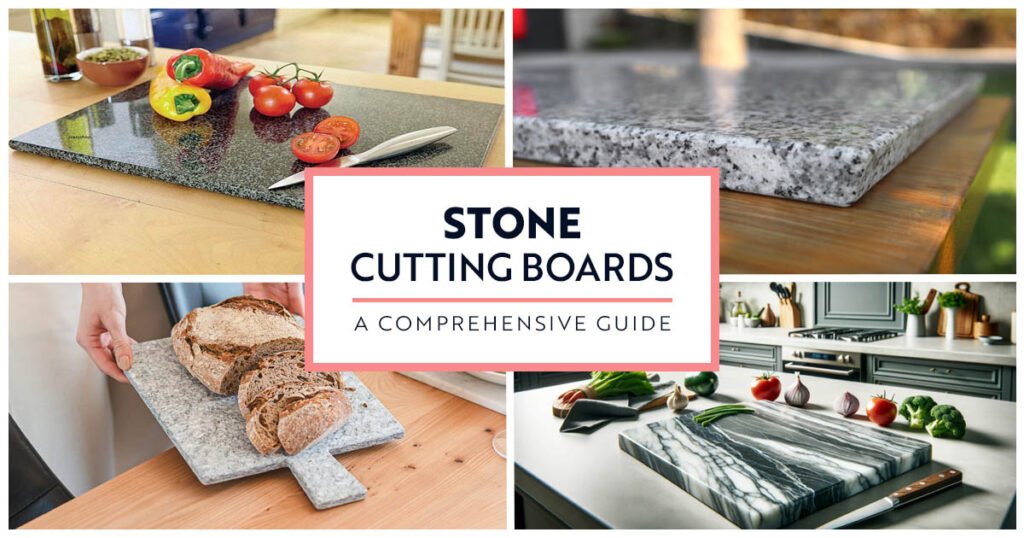
Stone Cutting Boards: A detailed guide
Choosing the right cutting board is very important for preparing food. Stone cutting boards, known for their strength and elegant looks, offer a unique mix of usefulness and style. In this detailed guide, we’ll look at the features, benefits, uses, care tips, and considerations of stone cutting boards, helping you understand why they are treasured in kitchens worldwide.
The Characteristics of Stone Cutting Boards:
Stone cutting boards are made from different types of natural stone, including marble, granite, slate, and soapstone. These boards are known for their durability, heat resistance, and non-porous surface, making them great for food preparation. Stone cutting boards come in various sizes, shapes, and colors, each with its unique charm and character.
Benefits of Stone Cutting Boards
- Durability:
Stone cutting boards are incredibly strong and resist wear and tear. Unlike wood or plastic boards, which can warp or get deep scratches over time, stone cutting boards stay in great condition with minimal care. - Hygiene:
The non-porous surface of stone cutting boards doesn’t absorb liquids and odors, reducing the risk of cross-contamination and foodborne illness. This makes them easy to clean and sanitize, ensuring a safe and clean food preparation environment. - Heat Resistance:
Stone cutting boards naturally resist heat, so they can handle hot pots, pans, and appliances without getting damaged. This makes them useful for both preparing and serving food, as they can also be used as trivets or serving platters for hot dishes. - Aesthetic Appeal:
Stone cutting boards have a timeless elegance and sophistication that adds a touch of luxury to any kitchen. Their natural patterns, textures, and colors create a striking look on a countertop, making them both functional and decorative. - Versatility:
Stone cutting boards are suitable for many cutting tasks, from chopping fruits and vegetables to slicing meats and cheeses. Their sturdy build and large surface area provide a stable platform for food preparation, allowing for precise and efficient cutting.
Uses of Stone Cutting Boards
Stone cutting boards are versatile kitchen tools that can be used for a variety of tasks, including:
- Chopping fruits and vegetables
- Slicing meats and cheeses
- Rolling out dough for baking
- Serving appetizers and charcuterie
- Displaying culinary creations during parties or gatherings
Different types of Stone Cutting Boards : Granite, Marble, Quartz, and Slate
Granite Cutting Boards
Granite cutting boards are very durable and heat-resistant, making them excellent for both food preparation and serving hot dishes. Their dense, non-porous surface resists bacteria and stains, ensuring a clean workspace. However, their hardness can be tough on knife blades, potentially dulling them faster than softer surfaces. Also, granite’s weight and fragility require careful handling to prevent chipping or cracking.
Marble Cutting Boards
Marble cutting boards are prized for their elegant, luxurious look and cool surface, ideal for working with pastry and dough. They are non-porous and resistant to heat and stains, contributing to a clean and easy-to-clean work area. Despite these benefits, marble’s extreme hardness can dull knives quickly, and it can get scratched and damaged by acids from certain foods, requiring careful maintenance.
Quartz Cutting Boards
Quartz cutting boards offer a unique mix of beauty and practicality. Made from natural quartz crystals and resin, these boards are incredibly durable, non-porous, and resistant to stains and bacteria. Their sleek, modern look makes them a stylish addition to any kitchen. However, like other stone surfaces, quartz can be hard on knives and relatively heavy, requiring careful use and handling to avoid damage
Slate Cutting Boards
Slate cutting boards provide a rustic, natural look that appeals to those seeking a distinctive kitchen accessory. They are durable, non-porous, and resistant to heat and stains, ensuring a clean and easy-to-clean surface. Slate’s slightly rough texture can be gentler on knives compared to other stones, but it may still cause some wear over time. Additionally, slate’s natural brittleness means it can chip or crack if not handled carefully.
Each type of stone cutting board—granite, marble, quartz, and slate—offers unique benefits and considerations. While they all provide durable, heat-resistant, and clean surfaces, their hardness can affect knife sharpness and require careful handling to avoid damage.
Care Tips for Stone Cutting Boards
Proper care is essential to maintain the beauty and functionality of stone cutting boards. Tips:
- Hand Wash Only: Wash stone cutting boards by hand with warm, soapy water after each use. Avoid soaking the board or placing it in the dishwasher, as this can cause damage.
- Dry Thoroughly: After washing, dry the cutting board thoroughly with a clean towel and let it air dry completely before storing.
- Apply Mineral Oil: Periodically apply a food-safe mineral oil to the cutting board to keep the stone in good condition and enhance its natural shine. Apply the oil in a thin, even layer, and let it soak in before wiping off any excess.
- Avoid Harsh Cleaners: Avoid using strong cleaning agents or abrasive scrubbers on stone cutting boards, as these can damage the surface. Stick to mild dish soap and a non-abrasive sponge or cloth for regular cleaning.
When Using Stone Cutting Boards
- Weight: Stone cutting boards are usually heavier than other types of cutting boards, which may affect their portability and ease of use.
- Cost: Stone cutting boards tend to be more expensive than wood or plastic boards due to the cost of materials and craftsmanship involved.
- Fragility: While durable, stone cutting boards can chip or crack if dropped or subjected to excessive force. Handle with care to prevent damage.
Conclusion
Stone cutting boards offer a blend of durability, elegance, and functionality that makes them a prized possession in any kitchen. With proper care and maintenance, they can provide a lifetime of reliable service while adding a touch of luxury to your cooking. Whether you choose marble, granite, slate, or soapstone, a stone cutting board will elevate your food preparation experience to new heights of sophistication and style
